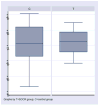Pedagogical Utilization and Assessment of the Statistic Online Computational Resource in Introductory Probability and Statistics Courses
- PMID: 19750185
- PMCID: PMC2740633
- DOI: 10.1016/j.compedu.2006.06.003
Pedagogical Utilization and Assessment of the Statistic Online Computational Resource in Introductory Probability and Statistics Courses
Abstract
Technology-based instruction represents a new recent pedagogical paradigm that is rooted in the realization that new generations are much more comfortable with, and excited about, new technologies. The rapid technological advancement over the past decade has fueled an enormous demand for the integration of modern networking, informational and computational tools with classical pedagogical instruments. Consequently, teaching with technology typically involves utilizing a variety of IT and multimedia resources for online learning, course management, electronic course materials, and novel tools of communication, engagement, experimental, critical thinking and assessment.The NSF-funded Statistics Online Computational Resource (SOCR) provides a number of interactive tools for enhancing instruction in various undergraduate and graduate courses in probability and statistics. These resources include online instructional materials, statistical calculators, interactive graphical user interfaces, computational and simulation applets, tools for data analysis and visualization. The tools provided as part of SOCR include conceptual simulations and statistical computing interfaces, which are designed to bridge between the introductory and the more advanced computational and applied probability and statistics courses. In this manuscript, we describe our designs for utilizing SOCR technology in instruction in a recent study. In addition, present the results of the effectiveness of using SOCR tools at two different course intensity levels on three outcome measures: exam scores, student satisfaction and choice of technology to complete assignments. Learning styles assessment was completed at baseline. We have used three very different designs for three different undergraduate classes. Each course included a treatment group, using the SOCR resources, and a control group, using classical instruction techniques. Our findings include marginal effects of the SOCR treatment per individual classes; however, pooling the results across all courses and sections, SOCR effects on the treatment groups were exceptionally robust and significant. Coupling these findings with a clear decrease in the variance of the quantitative examination measures in the treatment groups indicates that employing technology, like SOCR, in a sound pedagogical and scientific manner enhances overall the students' understanding and suggests better long-term knowledge retention.
Figures




References
-
- Anderson-Cook CM, Dorai-Raj S. Making the concepts of power and sample size relevant and accessible to students in introductory statistics courses using applets. Journal of Statistics Education. 2003;11 online.
-
- ASA . http://www.amstat.org/
-
- Becta. Primary schools–ICT and Standards. An analysis of national data from Ofsted and QCA by Becta. Coventry: Becta; 2003. http://www.becta.org.uk/research/research.cfm?section=1&id=538.
-
- Becta Ia. 2006. http://www.becta.org.uk/
Grants and funding
LinkOut - more resources
Full Text Sources
Miscellaneous
